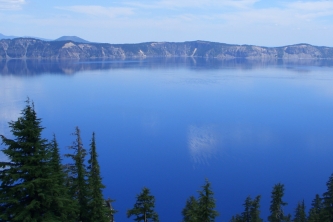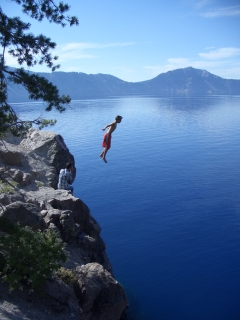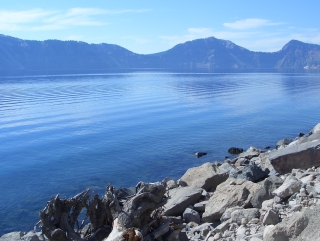Crater Lake National Park
Crater Lake, Ore.
Visited: August 6, 2005
NPS Site Visited: 225 of 353
NPS Website; Local Website
 WHAT IS IT? WHAT IS IT?
The remnants of a powerful volcanic eruption, 150 times stronger than Mt. St. Helens, that occurred just 7,700 years ago. Crater Lake sits in what was once the volcano’s cone and is the deepest lake in the United States.
BEAUTY (10/10)
The local Indians believed that if you looked into Crater Lake, you would die. The Lake maintains this aura of supernatural strength; you are looking straight into the core of an active volcano, there just happens to be water there. But what water it is, the clearest in all North America. Its blues are so untainted and so profound. It is the color blue in its purest form.
We stared at the Lake for untold time spans, trying to comprehend it and believe in its existence. This magical place cannot possibly be of this Earth. At the same time, it frightened Michael. Should we even be looking at the Lake? Are we stirring its demons by looking upon something that can never be known?
HISTORIC SIGNIFICANCE (3/10)
Just 8,000 years ago, Crater Lake was Mount Mazama. Then the explosion happened, the second largest volcanic eruption to occur in the United States in the last 750,000 years. The largest being the Yellowstone eruption some 650,000 years ago.
When Mount Mazama erupted, people were living in the area! We can only imagine how the volcano shaped the legends, stories and lives of the area’s peoples. Crater Lake’s modern history is less exciting. No one has ever lived in the area; white explorers did not even find the Lake until 1853. It became a National Park in 1902 and visitors have flocked ever since.
Prior to then, the local Indians regarded the Lake with reverence. They used its waters for ceremonial purposes and believed it to be a potent mystical force, which it surely is.
CROWDS (7/10)
450,000 people flock to Crater Lake NP every year, most coming in July and August. The Park’s high altitude, the Lake’s Rim stands between 7,000 and 8,000 feet above sea level, makes the visitation window very small. Nonetheless, the Park ably accommodates the large crowds. The scenic road has many pullouts and all the vistas are terrific. The campground generally fills every day, but most visitors tend to stay only one night. Consequently, spots are easy to find before 4:00 p.m.
 EASE OF USE/ACCESS (3/5) EASE OF USE/ACCESS (3/5)
The Park is located about 90 miles east of Interstate 5.
You can access it from the north via I-5 Exit 124 at Roseburg, then take Oregon Route 138 for 80 miles east until you get to the Park’s northern Entrance. From the south, take I-5 Exit 24 at Medford, then take Oregon Route 62 for 75 miles northeast until you get to the Lake.
A road circumnavigates Crater Lake’s rim and has numerous spectacular overlooks. Just ignore the thousand foot passenger side drop (no guardrails!) if you are driving around counter clockwise. Only one, very steep trail descends to the Lake’s shore. If you wish to take the Boat Tour, you need to make this descent.
CONCESSIONS/BOOKSTORE (3/5)
The bookstore carries a standard array of local history, posters and Crater Lake coffee table books. A Xanterra-run Rim Village Gift Shop sells chintzy Lake knickknacks.
COSTS (3/5)
Entry is $10 per car, free with the National Parks Pass. Campsites are $18 per site.
Tickets for the Ranger-led boat tours sell out quickly, especially the trips that leave early in the day. Tickets run $23.50 per adult, $14.00 per child and are on sale at the Cleetwood Cove Trailhead.
RANGER/GUIDE TO TOURIST RATIO (4/5)
Numerous Rangers staff the packed-to-the-gills Rim Village Visitor Center and try their hardest to answer the visitors’ many questions.
TOURS/CLASSES (7/10)
The Park’s one, tiny museum stands near the stunning Sinnott Memorial Overlook. The Museum includes about a dozen terrific interactive displays that explain the Lake’s turbulent past but is often very crowded. Rangers lead four talks a day just outside the Museum.
Ranger-led boat tours leave the Cleetwood Cove dock often. The boat ride sounds like a terrific way to spend the day. A short and informative introductory video is shown at the Mazama Village Visitor Center upon request.
 FUN (9/10) FUN (9/10)
We had a wonderful time at Crater Lake NP. The Park consists mainly of the Lake. The hiking opportunities are minimal and only one trail leads down to the water. One day is a sufficient visit to the Park.
WOULD WE RECOMMEND? (10/10)
You have not seen the color blue until you visit Crater Lake. The Lake is one of the most beautiful places on Earth.
TOTAL 59/80
|